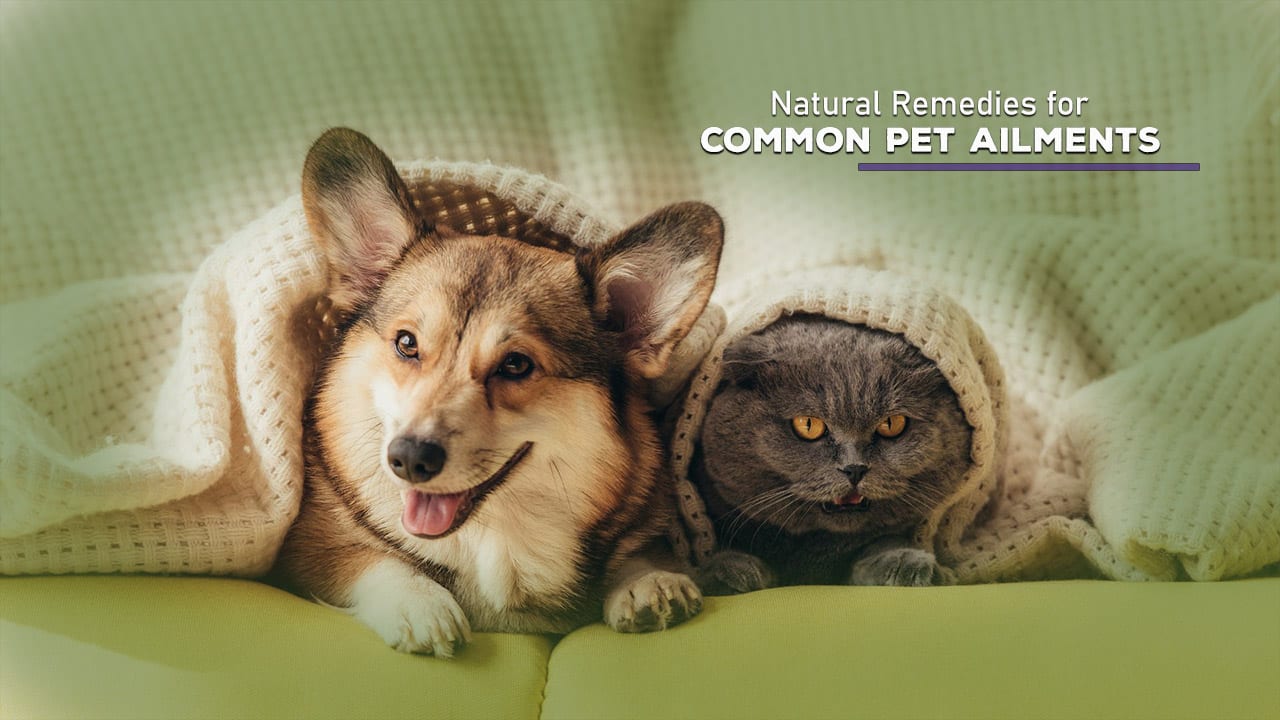As pet owners, we all want the best for our furry friends. When our pets aren’t feeling well, it’s natural to want to help them feel better quickly. While veterinary care is essential for serious health issues, natural remedies can treat many minor ailments safely at home.
These remedies often use herbs, foods, and other natural substances, providing a gentler alternative to pharmaceutical drugs with fewer side effects.
Natural pet remedies have gained popularity in recent years, reflecting a growing interest in holistic pet care. This guide explores natural solutions for common pet ailments, from skin problems to digestive issues, offering practical tips you can try at home.
We’ll discuss the benefits of natural remedies, precautions to take, and specific treatments for various ailments. You’ll better understand how to use natural remedies to support your pet’s health and well-being.
However, remember that while these remedies can be effective for minor problems, they should not replace professional veterinary care for serious health concerns. Always consult your veterinarian before starting any new treatment regimen.
Benefits of Natural Remedies for Pets
Before we dive into specific remedies, let’s explore why natural treatments can be beneficial for our pets:
1. Fewer side effects:
Natural remedies often have fewer side effects than pharmaceutical drugs. This can be especially important for pets with sensitive systems or those prone to adverse reactions. For example, while nonsteroidal anti-inflammatory drugs (NSAIDs) can cause stomach ulcers in some pets, natural anti-inflammatory agents like turmeric are generally gentler on the digestive system.
2. Cost-effective:
Many natural remedies use everyday household items or inexpensive natural products, which can be more affordable than prescription medications. For instance, an oatmeal bath for skin irritation can cost just a few cents compared to expensive medicated shampoos.
3. Holistic approach:
Natural remedies often address the root cause of the problem rather than just masking symptoms, potentially leading to better long-term health. For example, probiotics help with digestive issues and support overall immune function.
4. Complementary to conventional medicine:
Natural remedies can often be used alongside traditional treatments, providing a more comprehensive approach to pet health. For instance, acupuncture is sometimes used in conjunction with conventional pain management techniques for pets with arthritis.
5. Preventative care:
Many natural remedies can be used for treatment and preventing health issues before they occur. Regular use of omega-3 fatty acids, for example, can help maintain skin health and potentially prevent specific allergies.
6. Accessibility:
Many natural remedies can be administered at home, which can be less stressful for pets who get anxious at the vet’s office.
7. Environmental benefits:
Natural remedies often have a lower environmental impact than pharmaceutical drugs, which can contribute to water pollution when excreted or improperly disposed of.
Precautions When Using Natural Remedies
While natural remedies can be beneficial, using them safely is essential. Here are some precautions to keep in mind:
1. Consult your veterinarian:
Always consult your vet before starting any new treatment, even if it’s natural. They can advise on potential interactions with other medications and whether the remedy suits your pet’s condition. Dr. Judy Morgan, a holistic veterinarian, emphasizes: “Natural doesn’t always mean safe. Some herbs and supplements can interact with medications or be contraindicated for certain health conditions.”
2. Start slowly:
When introducing a new remedy, start with a small amount to see how your pet reacts. This is especially important for dietary supplements or topical treatments. For example, if you’re introducing coconut oil to your pet’s diet, start with just a quarter of a teaspoon and gradually increase the amount over time.
3. Watch for allergic reactions:
Just like humans, pets can be allergic to natural substances. Monitor your pet closely for any signs of an allergic reaction when trying a new remedy. Signs may include excessive scratching, swelling, difficulty breathing, or digestive upset. If you notice these symptoms, discontinue use immediately and consult your vet.
4. Use high-quality products:
If using herbal supplements or essential oils, ensure they are high-quality and safe for pet use. Not all products marketed for humans are safe for animals. For instance, many essential oils that are safe for humans can be toxic to cats. Always use pet-specific products or consult a holistic vet before using human-grade supplements.
5. Don’t delay veterinary care:
Natural remedies are great for minor issues but should not replace professional veterinary care for serious health concerns. If your pet’s condition doesn’t improve within a reasonable timeframe or symptoms worsen, seek veterinary attention immediately.
6. Be aware of contraindications:
Some natural remedies may not be suitable for pets with certain health conditions. For example, high doses of fish oil may not be appropriate for pets with blood clotting disorders.
7. Proper dosage is crucial:
Just like conventional medicines, the correct dosage of natural remedies is essential. Too little may be ineffective, while too much could be harmful. Always follow recommended pet-specific product dosages or consult a holistic vet for guidance.
8. Consider your pet’s overall health:
Your pet’s general health, diet, and lifestyle can all have an impact on the efficacy of natural remedies. A balanced, species-appropriate diet and regular exercise can enhance the effectiveness of many natural treatments.
9. Keep a record:
When trying new remedies, keep a journal of what you use, the dosage, and any changes (positive or negative) you notice in your pet. This information can be valuable for you and your vet when assessing the effectiveness of the treatment.
10. Be patient:
Natural remedies often work more slowly than conventional drugs. It may take days or even weeks to see significant improvement. Consistency in application is critical.
A prominent integrative veterinarian, Dr. Marty Goldstein, notes: “While natural remedies can be very effective, they’re not a magic bullet. They work best in a holistic approach to pet health, including proper nutrition, regular exercise, and stress management.”
Common Pet Ailments and Natural Remedies
Now, let’s explore some common pet ailments and the natural remedies to help alleviate them. We’ll discuss each ailment’s causes, symptoms and how natural remedies can help.
1. Skin Irritations and Itching
Skin problems are among the most common issues pets face. Allergies, fleas, dry skin, or other factors can cause them. Symptoms may include excessive scratching, redness, hair loss, and skin flakes.
Natural remedies:
a) Oatmeal bath:
Oatmeal has anti-inflammatory properties that can soothe itchy skin.
- How to use: Grind plain, unflavored oatmeal into a fine powder. Add a cup to warm bathwater and soak your pet for 10-15 minutes. Apply a paste with oatmeal and water to the affected areas for spot treatment.
- Why it works: Oatmeal contains avenanthramides and phenols with anti-inflammatory properties. It also helps to moisturize the skin and balance its pH.
b) Coconut oil:
Rich in fatty acids, coconut oil can moisturize skin and reduce inflammation.
- How to use: Apply a small amount directly to your pet’s skin, or add a teaspoon to their food for internal benefits. Start with 1/4 teaspoon per 10 pounds of body weight for dogs daily.
- Why it works: Coconut oil contains lauric acid with antimicrobial properties. It also helps to moisturize the skin and can improve coat health when ingested.
c) Apple cider vinegar:
Its antibacterial and antifungal properties can help with skin infections.
- How to use: Mix water and apple cider vinegar in a spray bottle. Apply to affected areas, avoiding open wounds or eyes. For internal use, add one teaspoon to your pet’s water bowl.
- Why it works: The acetic acid in apple cider vinegar has antimicrobial properties and can help balance the skin’s pH.
d) Chamomile tea:
Known for its soothing properties, chamomile can help relieve skin irritations.
- How to use: Brew a strong chamomile tea, let it cool, and use it to rinse your pet after bathing. You can also apply cooled tea bags directly to irritated areas.
- Why it works: Chamomile contains flavonoids and terpenoids with anti-inflammatory and antispasmodic properties.
e) Aloe vera:
Cooling and soothing properties can help with skin irritations.
- How to use: Apply a small amount of pure aloe vera gel to affected areas. Ensure the gel contains no added ingredients that might be harmful if ingested.
- Why it works: Aloe vera contains compounds that reduce inflammation and promote healing. It also has a cooling effect that can provide immediate relief from itching.
2. Digestive Issues
Digestion issues like diarrhea and upset stomach are frequent in pets and can result from dietary changes, stress, or minor infections. Symptoms may include vomiting, diarrhea, loss of appetite, and lethargy.
Natural remedies:
a) Pumpkin:
High in fiber, pumpkin can help regulate bowel movements.
- How to use: Add 1-4 tablespoons of plain, canned pumpkin (not pie filling) to your pet’s food, depending on size. For small dogs and cats, start with one teaspoon. For larger dogs, use up to 4 tablespoons.
- Why it works: Pumpkin is rich in soluble fiber, which can help firm up stools in cases of diarrhea and ease constipation. It also contains vitamins A and C, which support digestive health.
b) Probiotics:
These beneficial bacteria can help restore gut health.
- How to use: Look for pet-specific probiotic supplements or plain, unsweetened yogurt. Add 1-3 teaspoons of yogurt to your pet’s food, depending on their size.
- Why it works: Probiotics help to restore the balance of good bacteria in the gut, which can be disrupted by stress, antibiotics, or digestive upset.
c) Slippery elm:
This herb can soothe the digestive tract and reduce inflammation.
- How to use: Mix 1/4 teaspoon of slippery elm powder with water for every 10 pounds of body weight. Give before meals. For cats, use 1/4 teaspoon mixed into food.
- Why it works: Slippery elm contains mucilage, a slick gel when mixed with water. This gel coats and soothes the digestive tract.
d) Bone broth:
Rich in nutrients, bone broth can soothe the gut and provide hydration.
- How to use: Offer small amounts of homemade or store-bought bone broth (ensure it doesn’t contain onions or garlic). Start with 1 ounce per 10 pounds of body weight per day, divided into several servings.
- Why it works: Bone broth is easily digestible and rich in minerals and amino acids that support gut health. It’s also hydrating, which is essential during bouts of diarrhea.
e) Ginger:
It can help with nausea and vomiting.
- How to use: Give 1/4 to 1 teaspoon of fresh grated ginger for dogs, depending on size. For cats, use a pinch of ground ginger mixed into food.
- Why it works: Ginger has anti-inflammatory properties and can help soothe the digestive tract. It also has antiemetic properties, meaning it can help prevent vomiting.
A study in the Journal of Animal Physiology and Animal Nutrition found that dietary supplementation with pumpkin seed improved digestive health in dogs. The study showed that pumpkin seed supplementation increased the digestibility of nutrients and enhanced stool quality.
3. Arthritis and Joint Pain
As pets age, many develop arthritis or joint pain. While severe cases require veterinary care, natural remedies can help manage mild to moderate discomfort. Symptoms of arthritis in pets include stiffness, limping, reluctance to jump or climb stairs, and decreased activity.
Natural remedies:
a) Turmeric:
It contains curcumin, which has anti-inflammatory properties.
- How to use: Mix 1/4 teaspoon of turmeric powder with a bit of coconut oil and black pepper (to aid absorption) and add to your pet’s food. For larger dogs, increase to 1/2 teaspoon.
- Why it works: Curcumin, the active compound in turmeric, has powerful anti-inflammatory and antioxidant properties. The black pepper enhances absorption, while the fat in coconut oil helps as curcumin is fat-soluble.
b) Fish oil:
Rich in omega-3 fatty acids, which can reduce inflammation.
- How to use: Add fish oil supplements designed for pets to their food according to weight guidelines. Typically, the dose is about 20 mg per pound of body weight.
- Why it works: Omega-3 fatty acids, particularly EPA and DHA, are anti-inflammatory and can help reduce joint pain and stiffness.
c) Ginger:
It has anti-inflammatory properties and can help with pain management.
- How to use: Sprinkle a small amount of ginger powder on your pet’s food, or make a weak ginger tea to add to their water. For dogs, use about 1/4 teaspoon of powdered ginger per 10 pounds of body weight. For cats, use a pinch.
- Why it works: Ginger contains compounds called gingerols, which have anti-inflammatory and analgesic properties.
d) Massage:
It can improve circulation and reduce pain in arthritic joints.
- How to use: Gently massage your pet’s affected areas for a few minutes each day. Use circular motions and be gentle, especially around bony areas.
- Why it works: Massage can help improve blood flow to arthritic joints, reduce muscle tension, and relieve pain. It can also be a bonding experience for you and your pet.
e) Glucosamine and Chondroitin:
These supplements can help support joint health.
- How to use: Look for pet-specific supplements and follow the dosage instructions based on your pet’s weight. These often come in treat form for easy administration.
- Why it works: Glucosamine helps form and repair cartilage in joints. Chondroitin helps to keep cartilage healthy by absorbing fluid into the connective tissue. Together, they can help reduce joint pain and improve mobility. Glucosamine also has mild anti-inflammatory effects.
Typical dosages:
- For dogs: 20 mg glucosamine per pound of body weight daily
- For cats: 250 mg glucosamine per day for an average-sized cat
f) Green-lipped mussel:
A natural source of glucosamine, chondroitin, and omega-3 fatty acids.
- How to use: Available as a powder or in capsules. Follow the product’s dosage instructions based on your pet’s weight.
- Why it works: Green-lipped mussel contains a unique combination of omega-3 fatty acids, including ETA (eicosatetraenoic acid), which has potent anti-inflammatory properties.
4. Anxiety and Stress
Pets can experience anxiety due to various factors such as loud noises, separation, or changes in their environment. Signs of stress in pets may include excessive barking or meowing, destructive behavior, trembling, hiding, or changes in appetite.
Natural remedies:
a) Lavender:
Known for its calming properties.
- Use a few drops of pet-safe lavender essential oil on your pet’s bedding, or use a diffuser in the room (ensure proper ventilation). Never apply essential oils directly to your pet’s skin or allow them to ingest it.
- Why it works: The scent of lavender has been shown to have calming effects on the nervous system. A study in the journal Physiology & Behavior found that dogs in kennels were more relaxed and slept more when exposed to the scent of lavender.
b) Chamomile:
It can have a mild sedative effect.
- How to use: Brew a weak chamomile tea, let it cool, and add a small amount to your pet’s water. For a 50-pound dog, add about one tablespoon of cooled chamomile tea to their water bowl. For cats, use just a few drops.
- Why it works: Chamomile contains apigenin, a compound that binds to benzodiazepine receptors in the brain, producing a calming effect.
c) L-theanine:
An amino acid in green tea that can promote relaxation.
- How to use: L-theanine supplements are available for pets. Follow dosage instructions based on your pet’s weight. Typical dosages range from 25-100 mg for cats and small dogs and up to 400 mg for large dogs.
- Why it works: L-theanine increases the production of alpha brain waves, which are associated with a state of relaxed alertness. It also boosts levels of calming neurotransmitters in the brain.
d) Thundershirt or anxiety wrap:
While not traditionally a ” natural remedy, ” these wraps use gentle pressure to calm pets.
- How to use: Follow the product instructions to fit the wrap on your pet properly. Start by using it for short periods and gradually increase the duration.
- Why it works: The gentle, constant pressure has a calming effect similar to swaddling an infant. It’s believed to release calming hormones like oxytocin.
e) Valerian root:
An herb that can have a calming effect on the nervous system.
- How to use: Available in capsule or liquid form. For dogs, the typical dose is 1.5 mg per pound of body weight. For cats, use about 1/4 of the dog dose. Always start with a lower dose and increase gradually if needed.
- Why it works: Valerian root contains compounds that interact with GABA receptors in the brain, promoting relaxation and reducing anxiety.
f) Bach Rescue Remedy:
A blend of flower essences that can help calm stressed pets.
- How to use: Add a few drops to your pet’s water bowl or directly on their gums or paw pads. The pet version of this product does not contain alcohol.
- Why it works: While the mechanism isn’t fully understood, many pet owners report a calming effect. It’s believed that the vibrational energy of the flower essences can help balance emotions.
5. Urinary Tract Issues
Urinary tract infections (UTIs) and bladder stones are common, especially in cats. While severe cases require veterinary attention, natural remedies can help prevent and manage mild urinary tract issues. Symptoms may include frequent urination, straining to urinate, blood in urine, or urinating outside the litter box.
Natural remedies:
a) Cranberry:
This can help prevent bacteria from adhering to the bladder wall.
- How to use: Look for pet-specific cranberry supplements, or add a small amount of unsweetened cranberry juice to your pet’s water. For dogs, add about one teaspoon of juice per 20 pounds of body weight to their water daily. For cats, use just a few drops.
- Why it works: Cranberries contain proanthocyanidins, which prevent bacteria from sticking to the urinary tract walls. This can help prevent UTIs and may help manage mild cases.
b) Marshmallow root:
Has a soothing effect on the urinary tract.
- Use a weak tea with marshmallow root and add a small amount to your pet’s water or food. For dogs, use about 1/2 teaspoon of dried herb per 20 pounds of body weight. For cats, use about 1/4 of the dog dose.
- Why it works: Marshmallow root contains mucilage, which forms a protective coating on irritated tissues in the urinary tract, helping to soothe inflammation.
c) Increase water intake:
Proper hydration is crucial for urinary tract health.
- How to use: Always provide fresh water, consider a pet water fountain, or add water to dry food. For cats, you can also offer low-sodium chicken broth or tuna water to encourage drinking.
- Why it works: Increased water intake helps flush out the urinary system, dilutes urine, and makes it less hospitable for bacterial growth.
d) Apple cider vinegar:
It can help balance pH levels in the urinary tract.
- How to use: Add a small amount (1/4 to 1/2 teaspoon) to your pet’s water bowl. Start with a smaller amount and gradually increase to avoid putting your pet off their water.
- Why it works: Apple cider vinegar can help make the urine more acidic, creating a less favorable environment for bacterial growth.
e) D-mannose:
A type of sugar that can help prevent and treat UTIs.
- How to use: Available as a powder or in capsules. Use about 1/2 teaspoon per 10 pounds of body weight twice daily for dogs. For cats, use about 1/8 teaspoon twice daily.
- Why it works: D-mannose attaches to E. coli bacteria, preventing them from sticking to the urinary tract walls. The bacteria are then flushed out in the urine.
f) Parsley leaf:
A natural diuretic that can help flush out the urinary system.
- How to use: Add fresh chopped parsley to your pet’s food, or add a weak tea to their water. Use about one teaspoon of fresh parsley per 20 pounds of body weight for dogs. For cats, use just a pinch.
- Why it works: Parsley acts as a diuretic, increasing urine production and helping flush the urinary tract. It also contains antioxidants that may help reduce inflammation.
A study in the American Journal of Veterinary Research found that cranberry extract effectively prevented E. coli from adhering to canine kidney cells in vitro, suggesting potential benefits for urinary tract health. The study showed that cranberry extract prevented bacterial adhesion in a dose-dependent manner.
6. Minor Wounds and Cuts
Pets can sometimes get minor cuts or scrapes. While serious injuries require veterinary care, natural remedies can help with minor wound care. Signs that a wound needs veterinary attention include deep cuts, puncture wounds, excessive bleeding, or signs of infection like pus or severe swelling.
Natural remedies:
a) Calendula:
Has antibacterial and wound-healing properties.
- How do you use calendula tincture or ointment to clean minor wounds? For tinctures, dilute with an equal amount of water before applying.
- Why it works: Calendula has anti-inflammatory and antimicrobial properties. It can help speed up wound healing and reduce the risk of infection.
b) Aloe vera:
It Soothes skin and can promote healing.
- How to use: Apply a small amount of pure aloe vera gel to the affected area. Ensure you’re using 100% pure aloe vera without any added ingredients.
- Why it works: Aloe vera has anti-inflammatory properties and can help keep the wound moist, which promotes healing. It also has mild antibacterial properties.
c) Honey:
It has antibacterial properties and can help with wound healing.
- How to use: Apply a thin layer of raw, unpasteurized honey to clean wounds. Cover with a light bandage to prevent your pet from licking it off.
- Why it works: Honey has natural antibacterial properties due to its high sugar content and the presence of hydrogen peroxide. It also helps keep the wound moist, which can speed healing.
d) Epsom salt soak:
It can help clean wounds and reduce swelling.
- How to use: Dissolve Epsom salt in warm water and use it to clean the affected area gently. You can soak the paw in the solution for paw injuries for a few minutes.
- Why it works: Epsom salt (magnesium sulfate) can help eliminate toxins and reduce inflammation. The warm water also helps improve circulation in the area.
e) Coconut oil:
It has antimicrobial properties and can help soothe the skin.
- How to use: Apply a small amount of virgin coconut oil to the wound after cleaning.
- Why it works: Coconut oil has antifungal and antibacterial properties. It can also help keep the wound moist and soothe irritated skin.
- f) Chamomile tea compress:
It can help soothe irritated skin and minor wounds.
- How to use: Brew a strong chamomile tea, let it cool, and use it to make a compress. Apply to the affected area for 5-10 minutes at a time.
- Why it works: Chamomile has anti-inflammatory and mild antimicrobial properties. It can help soothe irritated skin and promote healing.
A review published in Veterinary Dermatology noted that honey has shown promise in wound management in veterinary medicine due to its antimicrobial and wound-healing properties. The review highlighted several studies where honey effectively treated various animal wounds.
7. Ear Infections
Ear infections are common in dogs, especially those with floppy ears. While chronic or severe infections need veterinary care, natural remedies can help with minor ear issues. Signs of ear infections include head shaking, ear scratching, redness or swelling in the ear canal, and a foul odor from the ears.
Natural remedies:
a) Apple cider vinegar and water solution:
It can help balance pH and fight bacteria.
- How to use: Mix equal parts apple cider vinegar and water. Use a dropper to apply a few drops into the ear, then gently massage the base of the ear. Use a cotton ball to wipe away any debris. Do not use it if the eardrum is perforated.
- Why it works: The acidity of the vinegar creates an environment that’s inhospitable to bacteria and yeast. It can help restore the ear’s natural pH balance.
b) Coconut oil:
Has antifungal properties.
- How to use: Melt a small amount of coconut oil and use a dropper to apply a few drops into the ear. Massage gently. You can also apply it around the outer ear area.
- Why it works: Coconut oil contains lauric acid, which has antifungal and antibacterial properties. It can also help soothe irritated skin in and around the ear.
c) Green tea:
It contains tannins that can help reduce inflammation.
- How to use: Brew a strong green tea, let it cool, and apply a few drops to the ear with a dropper. You can also use cooled tea bags to compress the outer ear area.
- Why it works: Green tea contains polyphenols and tannins with anti-inflammatory and antimicrobial properties. It can help soothe irritated ears and fight infections.
d) Oregano oil:
Has antibacterial properties.
- How to use: Mix one drop of oregano oil with 1/2 teaspoon of coconut oil. Apply a few drops to the ear. Never use undiluted oregano oil, as it can be irritating.
- Why it works: Oregano oil contains carvacrol and thymol, which have potent antimicrobial properties. It can help fight bacterial and fungal infections.
e) Mullein flower oil:
Has soothing and anti-inflammatory properties.
- How to use: Apply a few drops of mullein flower oil into the ear canal. Gently massage the base of the ear.
- Why it works: Mullein is anti-inflammatory and can help soothe irritated ear tissue. It’s often combined with garlic oil for added antibacterial benefits.
f) Calendula tincture:
Has antibacterial and healing properties.
- How to use: Dilute calendula tincture with equal water. Apply a few drops to the ear and massage gently.
- Why it works: Calendula has antimicrobial and anti-inflammatory properties. It can help fight infection and promote the healing of irritated ear tissue.
8. Bad Breath
Bad breath in pets can be a sign of dental issues, but in some cases, natural remedies can help freshen your breath. A veterinarian should evaluate persistent bad breath, which can indicate dental disease or other health problems.
Natural remedies:
a) Parsley:
Natural breath freshener.
- How to use: Finely chop fresh parsley and sprinkle a small amount on your pet’s food. For dogs, use about one teaspoon per 20 pounds of body weight. For cats, use just a pinch.
- Why it works: Parsley contains chlorophyll, which has natural deodorizing properties. It can help neutralize foul breath odors.
b) Coconut oil:
This can help reduce bacteria in the mouth.
- How to use: Add a small amount to your pet’s food, or use it for oil pulling (rubbing it on their gums). For dogs, start with 1/4 teaspoon per 10 pounds of body weight. For cats, use about 1/4 teaspoon total.
- Why it works: Coconut oil has antimicrobial properties that can help reduce bacteria in the mouth. It can also help reduce plaque buildup.
c) Apple cider vinegar:
It can help balance the pH in the mouth.
- How to use: Add a small amount to your pet’s water bowl. Start with a few drops and gradually increase to 1 teaspoon per large water bowl.
- Why it works: Apple cider vinegar can help create a less hospitable environment for odor-causing bacteria in the mouth.
d) Dental chews:
While not strictly “natural,” many contain natural ingredients that promote oral health.
- How to use: Offer appropriate dental chews as treats. Always supervise your pet when giving them chews.
- Why it works: Dental chews can help mechanically remove plaque and tartar. Many also contain ingredients like chlorophyll or enzymes that promote oral health.
e) Raw carrots or apples:
Natural tooth cleaners.
- How to use: Offer small pieces of raw carrot or apple as treats. Always supervise to prevent choking.
- Why it works: The crunchy texture can help scrape plaque off teeth. Apples also contain malic acid, which can help whiten teeth.
f) Probiotics:
It can help balance the oral microbiome.
- How to use: Look for pet-specific probiotic supplements and follow dosage instructions based on your pet’s weight.
- Why it works: Probiotics can help promote a healthy balance of bacteria in the mouth, potentially reducing odor-causing bacteria.
g) Cinnamon:
Natural breath freshener with antimicrobial properties.
- How to use: Sprinkle a small amount of cinnamon powder on your pet’s food. Use only 1/8 teaspoon for small dogs and cats and up to 1/4 teaspoon for larger dogs.
- Why it works: Cinnamon has antimicrobial properties and can help freshen breath. It may also help regulate blood sugar, contributing to better oral health.
h) Chlorophyll supplements:
Natural deodorizer.
- How to use: Look for pet-specific chlorophyll supplements and follow dosage instructions. You can also find chlorophyll-infused water at some pet stores.
- Why it works: Chlorophyll is a natural deodorizer that can help neutralize bad breath from the inside out.
A study in the Journal of Veterinary Dentistry found that certain plant-based ingredients in dental chews effectively reduced plaque and tartar in dogs. The study showed that dogs given a daily dental chew had significantly less plaque and tartar buildup after 28 days than dogs not given the chews.
9. Fleas and Ticks
While severe infestations require veterinary intervention, natural remedies can help repel and manage minor flea and tick issues. Signs of flea infestation include excessive scratching, visible fleas in the fur, and flea dirt (tiny black specks) on the skin.
Natural remedies
a) Diatomaceous earth:
A natural powder that can dehydrate fleas.
- How to use: Sprinkle food-grade diatomaceous earth on your pet’s coat, avoiding the face. Work it into the fur down to the skin. Reapply after bathing or swimming.
- Why it works: Diatomaceous earth comprises tiny, sharp fossils that physically damage the exoskeletons of fleas, leading to dehydration.
b) Apple cider vinegar spray:
It can help repel fleas.
- How to use: Mix water and apple cider vinegar in a spray bottle. Spray your pet’s coat before they go outside, avoiding the face.
- Why it works: The strong smell and taste of vinegar can deter fleas. It may also help balance skin pH, making your pet less attractive to fleas.
c) Neem oil:
Has insecticidal properties.
- How to use: Mix a few drops of neem oil with a carrier oil (like coconut oil) and apply to your pet’s coat. Use about one drop of neem oil per pound of body weight.
- Why it works: Neem oil contains compounds that repel and disrupt the life cycle of fleas and ticks.
d) Lemon spray:
The citrus scent can repel fleas.
- How to use: Steep lemon slices in hot water overnight, strain, and use the cooled liquid in a spray bottle on your pet’s coat. Avoid the face and any open wounds.
- Why it works: The strong citrus smell can deter fleas. Lemon also contains limonene, a compound known to repel insects.
e) Cedar oil:
Natural flea and tick repellent.
- How to use: Mix a few drops of cedar oil with a carrier oil and apply to your pet’s collar or bedding. Never apply essential oils directly to your pet’s skin.
- Why it works: Cedar oil has natural insecticidal properties and can repel fleas and ticks.
f) Rosemary dip:
It can help repel fleas.
- How to use: Steep fresh rosemary in boiling water, strain, and use the cooled liquid to rinse your pet after bathing.
- Why it works: Rosemary contains compounds that repel fleas and insects.
g) Beneficial nematodes:
Natural flea control for outdoor areas.
- How to use: Apply beneficial nematodes to your yard according to package instructions.
- Why it works: These microscopic worms feed on flea larvae in the soil, helping to break the flea life cycle.
h) Regular vacuuming and washing of pet bedding:
Mechanical flea control.
- How to use: Vacuum floors and furniture frequently, and wash pet bedding in hot water weekly.
- Why it works: Vacuuming can remove up to 50% of flea eggs from the environment. Hot water washing kills fleas in all life stages.
A study in Parasites & Vectors found that certain plant-based products, including neem oil, showed promise in repelling and killing fleas in dog fleas and demonstrated that a neem oil formulation effectively killed adult fleas and prevented flea eggs from hatching.
10. Allergies
Pets can suffer from environmental allergies, leading to itching and sneezing. While severe allergies require veterinary care, natural remedies can help manage mild symptoms. Signs of pet allergies may include excessive scratching, licking or chewing at paws, red or irritated skin, runny eyes, and sneezing.
Natural remedies:
a) Quercetin:
A natural antihistamine found in fruits and vegetables.
- How to use: Quercetin supplements are available for pets. Follow dosage instructions based on your pet’s weight. Typical doses range from 5-10 mg per pound of body weight daily.
- Why it works: Quercetin has anti-inflammatory and antihistamine properties. It can help reduce itching and inflammation associated with allergies.
b) Omega-3 fatty acids:
They can help reduce the inflammation associated with allergies.
- How to use: Add fish oil supplements designed for pets to their food according to weight guidelines. For dogs, a general guideline is 20 mg of EPA and DHA combined per pound of body weight. For cats, about 30 mg per pound of body weight.
- Why it works: Omega-3 fatty acids are anti-inflammatory and can help improve skin health, potentially reducing allergic reactions.
c) Nettle leaf:
It can help reduce allergic reactions.
- Use a weak nettle leaf tea and add a small amount to your pet’s food or water. For dogs, use about 1/2 teaspoon of dried nettle per 20 pounds of body weight. For cats, use about 1/4 of the dog dose.
- Why it works: Nettle leaf has antihistamine properties and can help reduce allergy symptoms.
d) Colostrum:
It can help modulate the immune system.
- How to use: Colostrum supplements are available for pets. Follow dosage instructions based on your pet’s weight. Depending on size, dogs ‘ typical doses range from 1/4 to 1 teaspoon per day.
- Why it works: Colostrum contains immune-modulating factors that help balance the immune system’s response to allergens.
e) Coconut oil:
It can help improve skin health and reduce inflammation.
- How to use: Add coconut oil to your pet’s food. Start with a small amount (1/4 teaspoon for small dogs and cats) and gradually increase to 1 teaspoon per 10 pounds of body weight daily.
- Why it works: Coconut oil has anti-inflammatory properties and can help improve skin health, potentially reducing allergic reactions.
f) Aloe vera:
It can help soothe irritated skin.
- How to use: Apply a small amount of pure aloe vera gel to irritated areas of skin. Ensure the gel contains no added ingredients that might be harmful if ingested.
- Why it works: Aloe vera has anti-inflammatory properties and can help soothe and heal irritated skin.
g) Apple cider vinegar rinse:
It can help soothe itchy skin.
- How to use: Mix equal parts water and apple cider vinegar. After bathing your pet, rinse them with this solution (avoid the head). Don’t rinse off.
- Why it works: Apple cider vinegar can help balance skin pH and has antimicrobial properties, which may help with secondary skin infections that often accompany allergies.
h) Probiotics:
It can help support the immune system.
- How to use: Look for pet-specific probiotic supplements and follow dosage instructions based on your pet’s weight.
- Why it works: A significant portion of the immune system is in the gut. Probiotics can help support a healthy gut microbiome, potentially modulating the immune response to allergens.
Summary
Natural remedies offer a valuable and gentle approach to managing common pet ailments. From soothing skin irritations with oatmeal baths and coconut oil to addressing digestive issues with pumpkin and probiotics, these remedies provide effective alternatives to conventional treatments.
Incorporating natural solutions into your pet care routine can enhance their well-being while minimizing potential side effects. However, it’s crucial to remember that natural remedies should complement, not replace, professional veterinary care.
Always consult your veterinarian before starting new treatments, especially for serious health concerns. By balancing natural remedies with professional advice, you can ensure the best possible care for your furry friends, promoting their overall health and happiness.







































